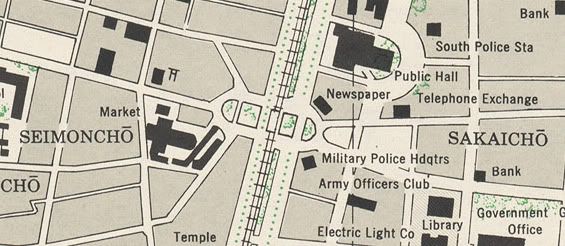The intersection's configuration dates back to the early days of Japanese colonization. After the Japanese empire took control of Taiwan in 1895, it took few delays in shaping Taipei into the island's provincial capital. In 1900, the colonial government began to dismantle its city walls, replacing them with a series of boulevards, including Zhonghua Road on the western side. The walled city's western gate was demolished and replaced by an elliptical plaza and traffic circle, shaped like a smaller version of the Place de la République in Paris. Railroad tracks were built in the median of Zhonghua Road shortly afterward.
That design remained essentially unchanged up through the 1980s, when the city embarked on several ambitious efforts to modernize its infrastructure. Underground railroad tunnels were built to replace all at-grade tracks west of Taipei Main Station; the Zhonghua Road rails were removed when the tunnels opened in 1989. Demolition of the struggling Zhonghua Market complex began in the following year. Later in the 1990s, Ximen Circle was rebuilt as a four-way intersection during construction of the Taipei Metro's first east-west subway route, now the Nangang Line. Both projects were completed in 1999.
 1972-2010
1972-2010Then and Now photographs:
1. Carpenter, N. "Oversea Chinese Emporium Ltd." 1970. Shulinkou Air Station. 24 Jul. 2010. http://members.tripod.com/Shulinkou/shimading2.jpg.
2. Duffin, L. "1972 shot of the same location and view as photo #1 above." 1972. Shulinkou Air Station. 24 Jul. 2010. http://members.tripod.com/Shulinkou/tpe019a.jpg.
Other photographs:
1. "0005017388 - 台北市西門町." 1978. 行政院新聞局. 國家文化資料庫. 行政院文化建設委員會. 2 Aug. 2010. http://nrch.cca.gov.tw/metadataserverDevp/DOFiles/jpg/00/05/12/33/cca100069-hp-0006640030-0001-i.jpg.
2. U.S. Army Map Service. "Taihoku-Matsuyama." 1945. Perry-Castañeda Library Map Collection. University of Texas Libraries. 2 Aug. 2010. http://www.lib.utexas.edu/maps/ams/formosa_city_plans/txu-oclc-6565483.jpg.



No comments:
Post a Comment